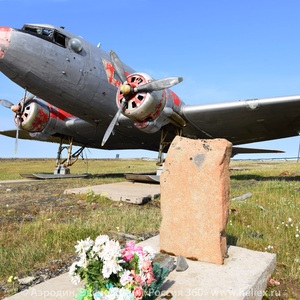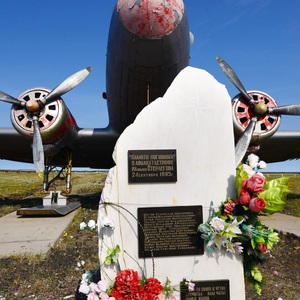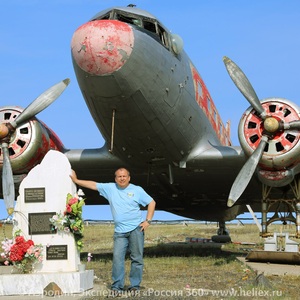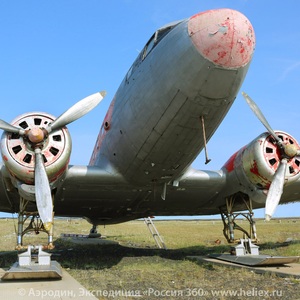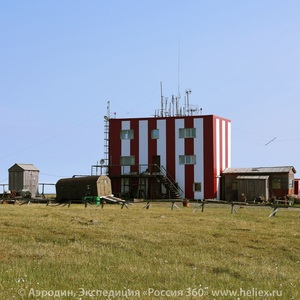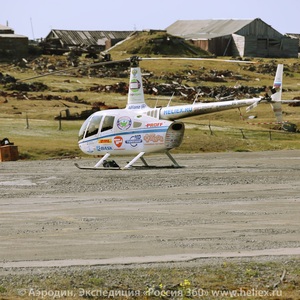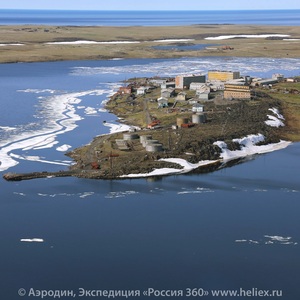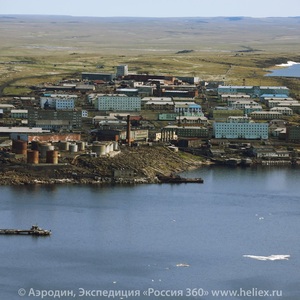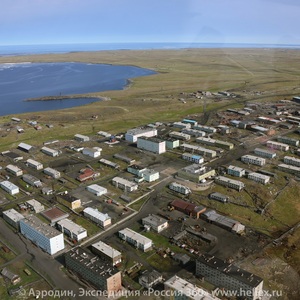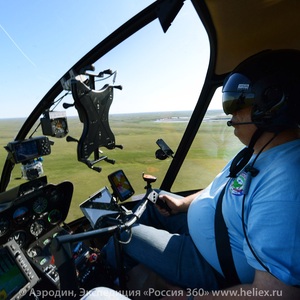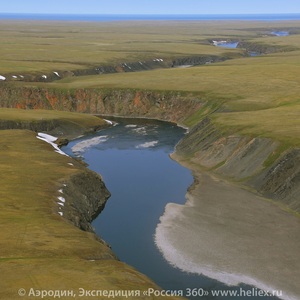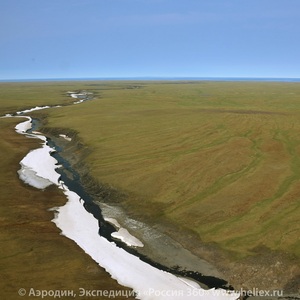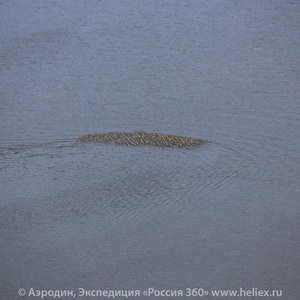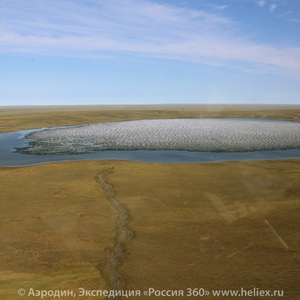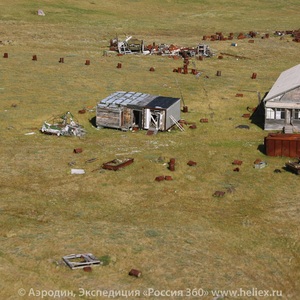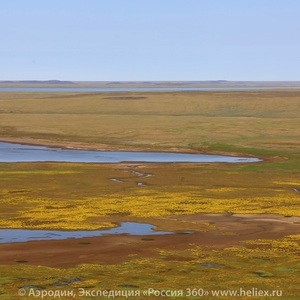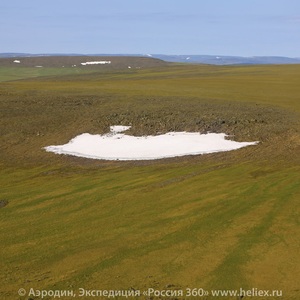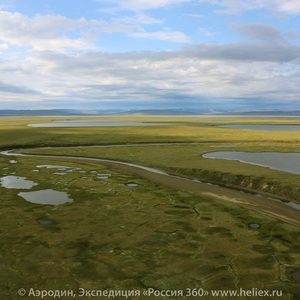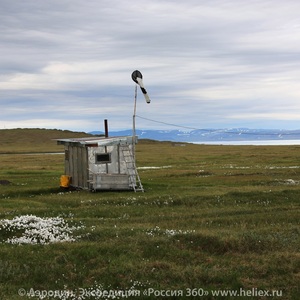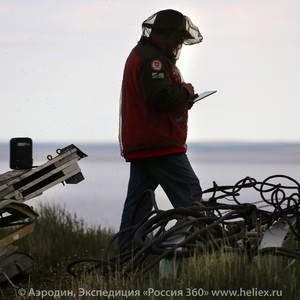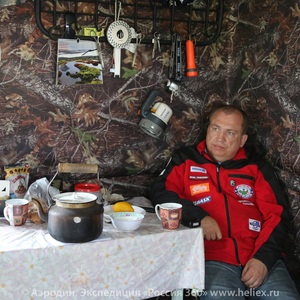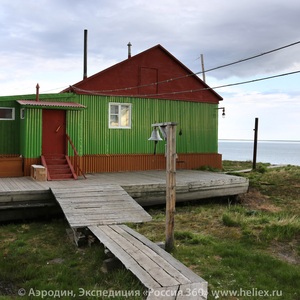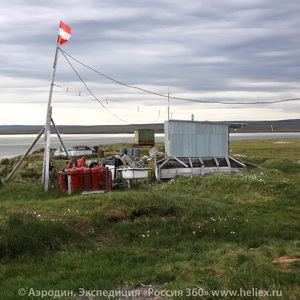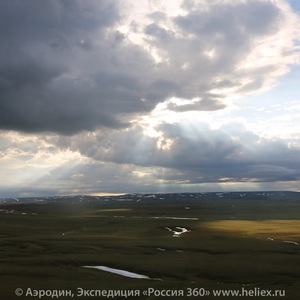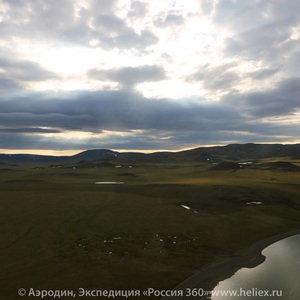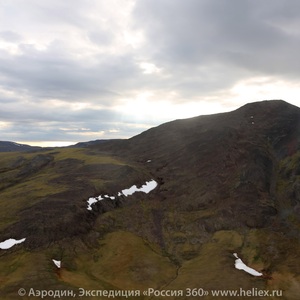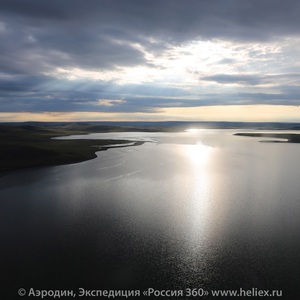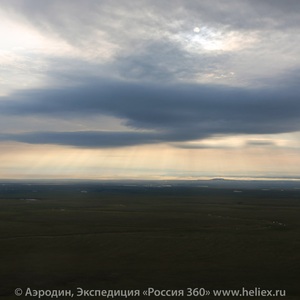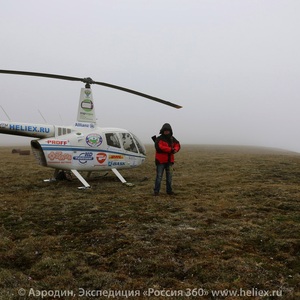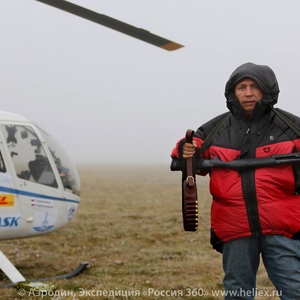We got u in the morning that was no different from the night, quickly had some tea and started to get off. Now we have to fly to the airort, refuel and move on a long journey – Lake Taimyr, and thence to the Cheliuskin Cae. But before that, we need to get in to the administration, to ay for the hotel, to arrive to the frontier ost, and to thank the administration for their hositality. We’re going in the UAZ on a dusty, backfilled with black slag from the boiler room, road and talk to the driver, Alexander, almost native citizen of the Dixon, who came here with his arents as a child. He knows a lot about the Sharo exedition, tells us about Chelingarov and many other eole who have been here. His oinion is not very ositive; he is quite sketical. Probably, he can be understood, because the modern history of Arctic exloration was held in front of his eyes, and we all see what it led to.
First we go to the border guards. We met a young lieutenant, he makes coies of our documents, and he is interested in our exedition. We tell him, leave our ennant and soon can go. All went very quickly. Arrive to the Dixon administration. Nice office building, in shar contrast with the views from the windows. We again met Alexander Alexandrovich. We say words of gratitude, because really, it would have been much more difficulty, if we were not allowed to land on the heliad of the townshi, if not a hotel and a car from the administration. We are taken a short interview from the local ublication, we hotograhed the Taimyr card, take a ief visit to the head of the administration. In arting, we are resented wonderful gifts – a book about Dixon and badges with the logo of the city. Thank you so much, dear Dixon friends! Desite the devastation and desolation in the village, the hositality of the native eole all the same. And it gives some hoe…
We request the airort for the flight from the mainland to the island and within a few minutes already came to land on the famous airfield. Aerodrome is big but comletely emty. I only see the Li-2 aircraft monument, which I know from hotograhs. We land on the aron. We have enough time before the dearture – the lan is submitted at 13:00 local time and we have another two hours. We thoroughly fuel our board – full main tank and 200 liters in extra.
Cheliuskin Cae is a remote olar station and the border ost, located at the northernmost oint of mainland Eurasia and, accordingly, in the north of the mainland of Russia. From Chelyuskin to the nearest oerating airort – and this is our Dixon or Hatanga – about 800 kilometers, that’s very far. Our ossible rogress, taking into account the extra fuel tank, is not less than 1000 km. In fact, even more – u to 1,200 km. But this is not guaranteed. The helicoter is flying in the air and deends on the winds. If the wind is countering, the range is less. Therefore, in contrast to cars, the fuel consumtion of the aircraft is not er 100 kilometers, but er flight hour. Robinson R66 helicoter has fuel consumtion about 90 liters er hour. The main fuel tank has 297 liters, otional about 290 as well. It turns out, that with the full loading, we have about 580 liters of fuel on board, which is at a rate of 90 liters er hour gives us the oortunity to fly for at least 6 hours (with resect to the necessary amount of fuel, according to the FAP). The average seed of the helicoter is about 110 knots or 200 km / h. So, our range is 1,200 km. However, as I said, it all deends on the wind. It can be not only incidental, but also counter, that reduces wayoint seed. Besides, the weight of the cargo is also imortant. If, like in our case, it is fully loaded, it flies slower. And then there are things like stoovers. Sometimes we make them to take ictures, to relax (and Victor – to smoke) or some other necessities… Stoovers also require fuel consumtion. That is why in our calculations we rely on the ractical range of 1000 km maximum.
It seems like we have enough fuel to fly from Dixon to Chelyuskin. Why not go there at once, directly? Why do we have a lanned landing sot along the route at Sablera Cae, at Lake Taimyr? Do not forget that after we could reach u to Chelyuskina, we need to come back also. But there are roblems with fuel on Chelyuskin. Technically, the fuel is available. At the border guards. Because to the Cheliuskin itself, and further to Northern Lands, fly helicoters of the Border Service. But our aeal to the Office of Border Guards was, alas, refused. Referring to the inability to discharge fuel at other needs but to the needs of the border guards themselves or for rescue oerations, we were denied the allocation of fuel for the exedition. Although we need quite a little… Our small aircraft consumes mere dros of fuel comared to the fuel consumtion of border Mi-8. I think no one would have suffered and would not even noticed the flow of requested by us 500 liters. The iceeaker “Somov” imorts hundreds of tons of fuel here. But the owner had their reasons and it is not for us to judge. “No” means “no”.
What shall we do? How to reach the end oint in the north of Russia? We found the following way… We have learned that the lake Taimyr has a fishing base, located on Cae Seblera, where sometimes flies a helicoter. There is a suly of fuel. And we were able to agree that we will refuel there. We were very hay about this, desite the fact that the rice of kerosene TS-1 was equal to the rice of aviation gasoline 100LL. In these distant lands no lace for whims. In addition, it is worth remembering that the delivery of fuel here by all-terrain vehicles along the winter roads itself is very exensive. In short, we have found a way out of the situation – we are flying from Dixon to Cae Sablera to the fishermen, then fill our tanks back under till the covers. Given the fact that it is about 400 kilometers from here to Chelyuskin, we have enough fuel to go to the Cheliuskin and back with our own stocks, without the hel of guards. Uon returning from Chelyuskin, we will fill them again on Sablera and fly down the route to the nearest airort in Hatanga or Saskylahe.
The road from Dixon to Lake Taimyr is long. Given the circumvention of the mountains, more than 600 km. And most imortantly, when oerating in the Polar Circle and the Arctic, you should always have a suly of fuel. Places here are comletely wild and uninhabited. In emergency case, the rescue forces can be delayed for long, because, among other things, the weather here changes frequently and unredictably. Additional fuel may be required to fly away from the bad weather, or any other unexected reason. Therefore, we reasoned that the extra fuel will not harm us, and refueled thoroughly in Dixon. We still had time before dearture, the mobile Internet from Beeline was very slow, and I was sitting with a tablet and watched weather forecasts on the Taimyr Peninsula. Judging by the movement of clouds and air masses, now the northern Taimyr has bad weather. But the rain clouds quickly carried to the southeast, and the Taimyr must be cleansed from the weather by late evening today, Monday. All day tomorrow the Taimyr Peninsula should have good weather, but by the evening of Tuesday the north-west was inging a big cold front that threatened by rolonged rain and bad weather for three days. Thus emerges a window around one day of duration, when we have the chance to fly to the Cheliuskin with good weather. The original lan to send the night on the Chelyuskin not seemed to take lace. If we send the night there, and we catch u with the bad weather, we’d be stuck for a few days, and it’s not in our lans. To verify the accuracy of my redictions, I go to the tower to seak with a meteorologist about the weather. Yes, everything is more or less as I said. Satellite image clearly shows a black wall, moving from the north-west and is clearly visible lumen, during which we have to fly to the Cheliuskin.
We have already managed to cature the anorama of the airort and take ictures at the monument to the Li-2 aircraft. Preared the craft, the camera, the route to the navigator… Now we can fly. We say goodbye to the airort staff, in memory, following our tradition, we give our signature banners and souvenirs. We are heavy, but take off well. The strong eeze, that immediately catches the helicoter on a forward blasting, hels a lot. We make arting shots of Dixon from the air and now only tundra is in front of us. Nearly 4 hours of flight go smoothly, but boring – nothing secial to see or remember. For a change, flying low, at low level flight, make videos, take ictures. The weather is fine, although we move to the erihery of the already owerful warm air mass that kees the surrounding regions in the soft summer climate. There is only one minus of it in the north – mosquitoes, gnats and horseflies. They are literally obsessing us.
Here we go around the mountain from the south, going along the great Taimyr sea, stretching for thousands of square kilometers. Here’s the cae Sablera, here one can see some buildings… We make a circle, we see a erson running and oints us a lace where to land. We land. We oen the doors to let in some fresh air and then hundreds or thousands of mosquitoes rushed into the cabin…That’s so awful! Within minutes, I realize that here it is, the moment when it’s time to ut on mosquito nets. Fishermen are worried about mosquitoes less than we do. And besides, I thought they somehow are not even interesting for the mosquito swarm. Obviously, we’re aliens and smell good for them :-)
Here on a seasonal fishing live three fishermen. They go fishing in the summer and winter. During the off-season they deartures to Hatanga, and other times they fish, ut the network and ull huge Taimyr fishes – whitefish and char… They make us their guests, and we talk slowly. One of the fishermen is the former mechanic from the Mi-8 helicoter, and he is interested in our helicoter, our exedition. In their house they already have a few ennants of other exeditions hanging on the wall. These are the exeditions that go to Taimyr and on Cheliuskin: “North Landing”, “Russian Flight”… We are adding our own ennant to this collection. Meanwhile, I kee thinking about the weather. Took out our Inmarsat satellite terminal and go, looking for a lace with a more or less good signal. Actually, judging by the coverage ma of Inmarsat satellites, there should be no connection. But to my surrise there is a signal. I climb u on a ole and fits the terminal there. The signal is not constant, the connection is interruted, but sometimes the Internet is available. I run my synotically rograms on iPad and monitor the weather. Within a few hours the icture has became more accurate, and it’s imortant for me to know whether the situation has changed. We even managed to check in at Facebook and write a few words. The weather is generally changing as redicted. So far it’s cloudy – a coule hours ago there were rains here on Sablera, too. But it is clear that in the west the sky slowly becomes clear. Its 19:00 now and I’m wondering what to do – send the night and wait for Sablera guaranteed weather? But then we will have very limited time to fly to Cheliuskin, send some time and have time to go back until the next storm came. Maybe, we can fly out today – forecast also shows that the night sky should have cleared. Then we can send the night on the Chelyuskin and we will have a whole day to shoot and getting to know eole. We consult with Victor and decide that we need to save time. It’s better to fly now. While we reach, the weather should get better.
We say goodbye to the fishermen for the whole day. We need to get back here by tomorrow night. Refuel, take off and head for the north. Weather is changeable, but we see a trend towards imrovement. At some oint, we even fly in the sunshine. Here’s Lake Taimyr, there are mountain ranges, which I saw so many through the Google Earth. We fly for about 100 kilometers from Sablera, when it is gradually becoming overcast. I’m not really afraid of it, remembering the redictions of my rograms on the tablet – these are the remnants of the assing away to the south-east storm. Relief begins to rise slowly. Hmm, that’s not good. The lower edge of the clouds began to descend too, as we move to the north. It’s no longer sunny, but gray and overcast with occasional dros of rain on the blister, but with no rain clouds in sight. If only we can get there soon, judging by the navigator we still have to fly for an hour! I feel that vises between declining clouds and rising terrain are beginning to inch us. I look at the ma of the terrain. Before us is the mountainous terrain, it is much closer to circumvent from the west. But there is quite a water barrier – the Gafner Fjord bay. It’s a tra to fly above the gray water without seeing the other side, under the low gray clouds. There awaits the loss of visual orientation with the most unfortunate consequences. I know very well how many helicoters crashed because of that. I am going away from mountainous terrain to the left and we already see that the tos of the low, in general, mountains are in the clouds. Thus the lower edge is down to 100 meters or even less. And here is the big water. We are flying already over the surface. We can’t fly higher because of the clouds. But the horizon is still visible, and we decide that we need to ass the bay from the west. There is a narrow idge, where the other side is at hand. There is a chance, that’s where we’ll see the other side and be able to cross the bay, beyond which there is a nisin. Then it will be easier.
I’m droing the seed, we’re flying only 10 meters above the ground, but there are roblems ahead of us. I’m beginning to lose the horizon. It seems there is fog. Damn, this is mostly unfortunate. To fly into the mist means to look for your own death. We find a atch of solid ground on the shore of the bay (around swams), and there we land. In less than five minutes the dense fog surrounds us. So it was not just a wall – it moved towards us, from the ocean side. Aarently, these are the most outrigger fogs, about which the exerienced olar ilots warned me. Who might have thought! No, I knew this might haen and we are reared for it. But when faced with the roblem – even exected – directly, the mood is soiled. Our lans to get on Cheliuskin today, it seems, are soiled. Its uncear how long this fog will last.
We get out of the helicoter. Boy, it’s so cold here! I looked at the thermometer, it shows only 5 * C. Plus the damness of the fog that reaches to the bone. We decide to dress extra clothes urgently. We have warm clothing from BASK – down jackets, thermal underwear, warm jackets and ants. Under my jeans I wear olartek ants, over the autumn jacket – thermal jacket. Now I feel good. Victor decides to wear just down jacket. Slowly comes the ainful understanding – erhas we will have to wait the whole night. Usually, mists are scattered only by the day sun and its heat.
We get our SPEC.PIT emergency suly. Oen one ackage. We have to make the canned food hot, but it’s very hard to set fire to the dry sirit tablet on this wet wind. Victor fears that there may be olar bears roam here, and the smell of food can attract them. For the first time we ull out our gun. And we’ve never been fired from it before! We decide we need to ractice. There is a buried in the ground rusty 200-liter barrel nearby – these barrels are scattered across the whole tundra. During almost 100 years of Arctic exloration there have been accumulated millions of them and now it is a real environmental roblem. There are even government rograms about it – to clear at least the olar stations from the mountains of rusty iron. But so far it’s only talks. First we unack a signal rocket – shoot, but it immediately disaears into the mist. Then ull out the cartridges with lead shots – we need them the least, it does not scare away the bear. We shoot in turns at the rusty barrel. Well, the rifle is sort of shooting. Victor armed as basmach – hangs the gun over, ammunition belt on the belt, but he doesn’t look fearsome in his jacket. Rather comical :-)
With the hel of the Iridium satellite hone we talk with our staff, and reort the situation. Headquarters asks to dictate an audio message, so that we won’t be worried about. I’m dictating a message which they will uload on our website and Facebook. Then the regional administration Aerosace Search and Rescue duty officer calls, we reort that we have a full control – just waiting out the bad weather. And it seems like everything is really good – eole are alive and well, technical arts are in order, we have enough weaons, clothing, water, food and communication. Well, just a small trek to the tundra with an overnight stay. Not a challenge…
We finally warm u the stew and eat it with biscuits. We eat it together with ate and chocolate mass. Life is getting better! :-) It’s imossible to make tea here – there is nothing to burn for the fire, and it’s too troublesome to get our tile-burner. So it is also necessary to filter the water, which we don’t have either – the water in gulf is salty. We decided to use the remaining reserves of drinking water in the bottles. To while away the time with some benefit, we decide to wash the tail of the helicoter from soot. As our aircraft is not white, but dark gray, sometimes black. We have some rags there – we dissolve one dirty T-shirt. We first wash with water and shamoo, then with kerosene – get a lot better. The helicoter is washed out. We gather all the rags and burn them. Unfortunately, we can’t warm ourselves near the small cam fire – as it is immediately blown by the wind and moisture, while rags only smoke. We get into the helicoter – it’s cold, but at least it does not blow. We’ve been sitting for two hours already, and the fog does not seem to get thinner. We lower hoods down to the eyes, having nothing to do but na. It’s terribly inconvenient to slee in this osition. But ste by ste the fatigue takes us, and there comes a dream, intersersed with anxious thoughts and eriodic eek through the misted glass – did it come any better? The day began cheerfully, but somehow ended a little sad. Well, tomorrow is another day.
P.S. The result of the day – 917 kilometers in 5:24 flight hours


